|
SAAB J29A/B Tunnan
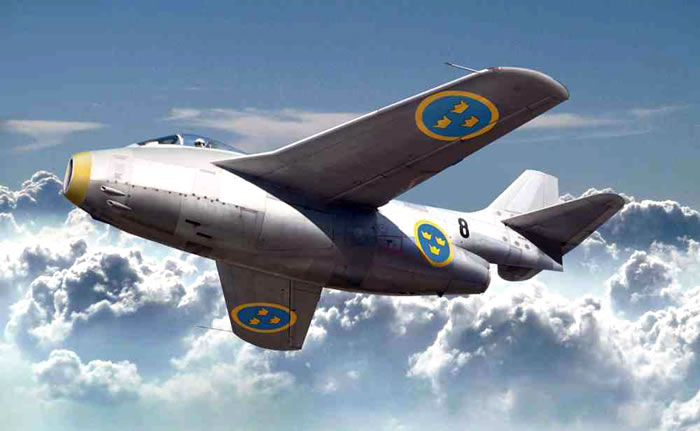
Tarangus, 1/72 scale
S u m m a r y : |
Catalogue Number: |
Tarangus Kit No. TA7201 - SAAB J29A/B Tunnan |
Scale: |
1/72 |
Contents & Media |
45 grey styrene, three clear styrene, and five resin parts; with decals for three subjects. |
Price: |
Available online from:
|
Review Type: |
First Look |
Advantages: |
Very refined surface detail, nice interior detail, and good decals. |
Disadvantages: |
No harness with the resin ejection-seat;a missed opportunity to offer more under-wing stores. |
Conclusions: |
This is the first 1/72 kit by Tarangus, and I hope they do more Tunnan versions as well the likes of a Viggen and Lansen. Quality is very good for a limited run kit, as I would expect given its likely Sword origin. It is good to have a modern and accurate Tunnan kit, especially as of the earlier J.29A/B versions.
This new release from Tarangus is comparatively expensive, costing around 70% more than an equivalent kit by Sword (for example). I am inclined to think that many who just want any version of Tunnan in 1/72 will stick with the much more affordable Heller kit (or indeed convert it to an earlier A or B version). But for those who want an early Tunnan without resorting to surgery, or desire better accuracy and the refined surface detail of a modern limited run kit, then the new Tarangus release is the one to go for. I am happy to recommend it. |
Reviewed by Mark Davies

Valom's 1/48 scale An-2 Colt is available online from Squadron.com
Background
(Source: Wikipedia)
The Saab 29, popularly called Flygande Tunnan ("The Flying Barrel"), was a Swedish fighter designed and manufactured by Saab in the 1950s. It was Sweden's second turbojet-powered combat aircraft, the first being the Saab 21R. Despite its rotund appearance, the J 29 was fast and agile, serving effectively in both fighter and fighter-bomber roles into the 1970s.
In the aftermath of the Second World War, it was decided that Sweden needed a strong air defence built around the newly developed jet propulsion technology. Project "JxR" began in the final months of 1945 with two proposals from the SAAB design team led by Lars Brising. The first, codenamed R101, was a cigar-shaped aircraft somewhat similar to the American Lockheed P-80 Shooting Star. The winning design however was the "barrel" design, codenamed R 1001, which proved to be both faster and more agile.
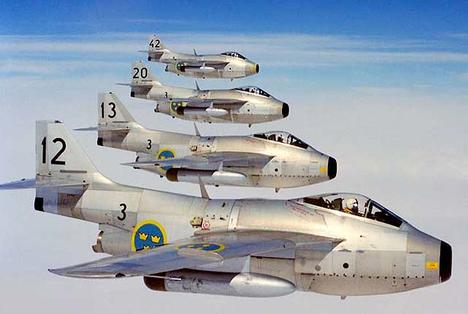
The original R 1001 was designed around a mostly straight wing, but after the Swedish engineers had obtained some German research data on swept-wing designs, the prototype was altered to incorporate a 25 degree sweep, first tested on a modified Saab Safir (designated Saab 201). A member of the Saab engineering team had been allowed to review German aeronautical documents stored in Switzerland. These files captured by the Americans in 1945 clearly indicated delta and swept-wing designs had the effect of "reducing drag dramatically as the aircraft approached the sound barrier." The SAAB 29 prototype flew for the first time on 1 September 1948. It was a small, chubby aircraft with a single central air intake, a bubble cockpit and a very thin swept-back wing. The test pilot was an Englishman, Robert A. 'Bob' Moore, who went on to become the first managing director of Saab GB Ltd, UK, set up in 1960.
Moore described the aircraft as "on the ground an ugly duckling – in the air, a swift." Because of its rotund appearance, The Saab J 29 was quickly nicknamed "Flygande Tunnan" ("The Flying Barrel"). A total of 661 Tunnans were built from 1950 to 1956, making it the largest production run for any SAAB aircraft.
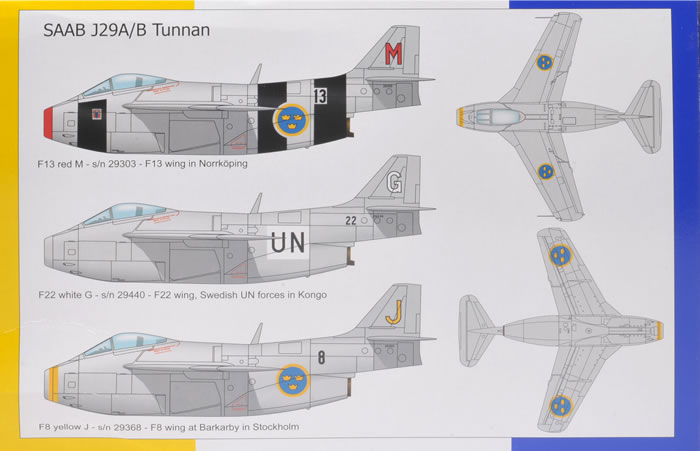
The fighter version was retired from active service in 1965, but some aircraft were used for target towing up to 1974. The last official military flight was completed in August 1976 at the Swedish Air Force's 50th anniversary air show.
A total of 30 Tunnans were sold to Austria in 1961 where they remained in service until 1972.
Previous 1/72 scale Tunnans
The kit appears to possibly have been produced by Sword as the sprues and instructional format bear a very strong resemblance to this brand's products. I am at least sure that it is of Czech origin.
The kit comes in a typically Czech end-opening box with digital artwork on the front. The instructions provide a parts map, and easy to follow diagrammatic assembly format. There is also a brief history of the aircraft. All text is in English. Painting and decal guides are adequate black & white shaded drawings. Very little mention is made of paint colours, but all schemes appear to be natural metal with any colour highlights readily determined from the coloured guides on the rear of the box. The instructions also provide a URL to the Tarangus website where the supposedly the black and white shaded diagrams can be viewed in colour; but all that I could find was a repeat of the box rear. Detail paint call-outs use generic colour names. A four-view stencil placement guide is also provided.
The parts come in a zip-lock bag, with the resin and clear parts further protected in their own small bags. The plastic has a more shiny finish than many other Czech limited run brands, which tends to support my contention of a Sword origin. All parts are well moulded with very fine and crisp surface detail. The parts break down is conventional, with narrow sprue gates. Some flash is visible in many places but will be easily dealt with. The resin parts are also produced to a good standard, as are the clear canopy pieces.
The cockpit detail is quite reasonable, and mainly dealt with using styrene parts providing the combined floor and rear bulkhead, instrument panel, one side-wall, throttle box, control-column and rudder pedals. The ejection seat is made of resin, but most regrettably lacks any harness detail; something I find hard to understand why. A nice resin gun-sight tops things off.
The fuselage halves enclose several parts in addition to the cockpit sub assembly just described. These include a resin intake throat (with compressor face at the far end), to which is added a styrene intake lip; one styrene nose and two resin wheel-wells, and finally a styrene exhaust nozzle. The need for nose ballast is indicated, but how much is not stated. The fuselage has room for plenty under the cockpit ahead of the main-wheel wells however. There are a couple of small dorsal air-scoops to add, along with the four cannon blast tunes. There is also what appears to be small heat-shield fitted to the lower circumference of the exhaust nozzle on some Tunnans. The instructions indicate that this is an optional part, and it seems to be related to two of the three colour scheme based on the painting guides. The small but noticeable retractable paired landing- lights that mount under the nose are provided as a clear styrene part. The two part canopy is quite thin and clear.
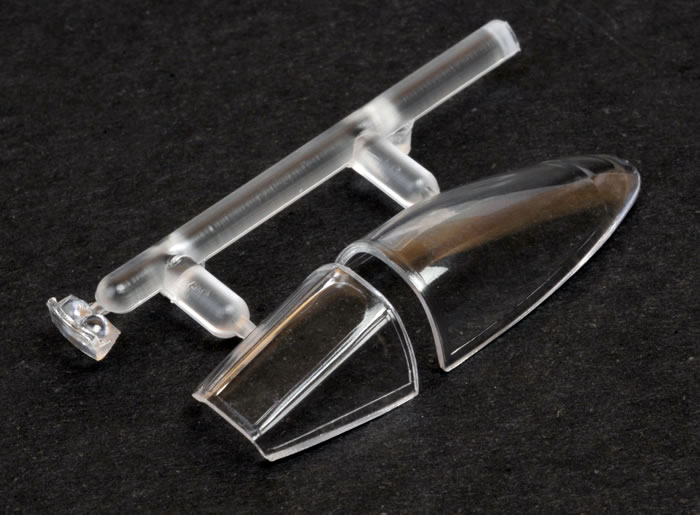
The wings and tailplane are simple affairs, although unusually for a limited run kit the wings have locating tabs to fit slots in the wing roots. The one-piece tailplane is a slide fit either side of the tailfin. I do not anticipate any major issues with gaps and filler in either case.
The undercarriage looks quite adequate, and captures the look of the fairly simple setup of the original. The main-wheels are split in two due to tooling requirements, and the nose-wheel is integral with the nose-leg. The undercarriage doors are simple affairs with some internal structure moulded on their inner faces.
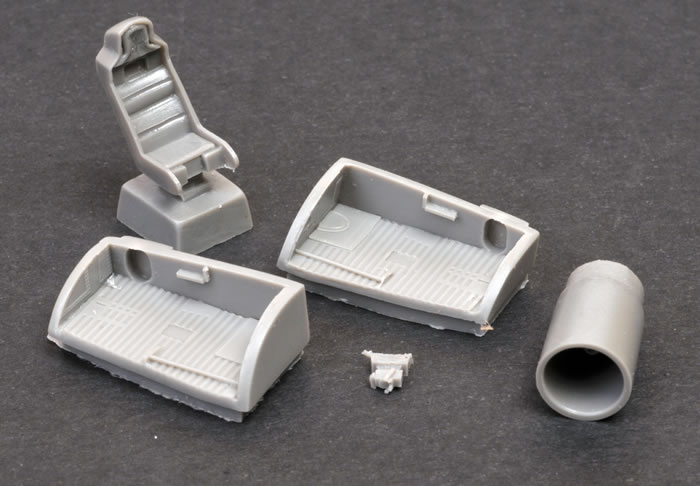
The only under-wing stores offered are two drop tanks, and as I understand things should only be fitted to B-versions of the kit. It is a pity that a wider choice of ordnance was not provided.
Overall, this appears to be fairly simple kit that should build well. The usual challenges of limited run kits like removing ejection stubs, thinning trailing edges and locating sub-assemblies satisfactorily. However, in this case there are least some location guides for the cockpit and main wheel-wells, whilst the wings have location tabs, and the intake and exhaust are simple insertion fits.
Colours & Markings
Three decal options are provided, all for natural metal aircraft, along with quite extensive stencil markings common to all.
The schemes are:
-
J-29A, s/n 29303, red M, F13 Wing in Norrkoping;
-
J-29B, s/n 29440, white G, F22 Wing, Swedish UN Forces in Congo; and
-
J-29B, s/n 29368, Yellow J, F8 Wing at Barkarby in Stockholm.

The decals are very crisply printed and appear to be of excellent quality.
Tarangus-Heller Comparison
As mentioned earlier, Tarangus has kitted the J.29A/B, which compliments rather than directly rivals the still nice Heller kit. I cannot recall reading any serious criticisms of the Heller kit's outline accuracy, so despite being a J.29E or late-S.29C, we can ignore the dog-tooth wing and compare most airframe parts with the new release and see how closely the two agree.
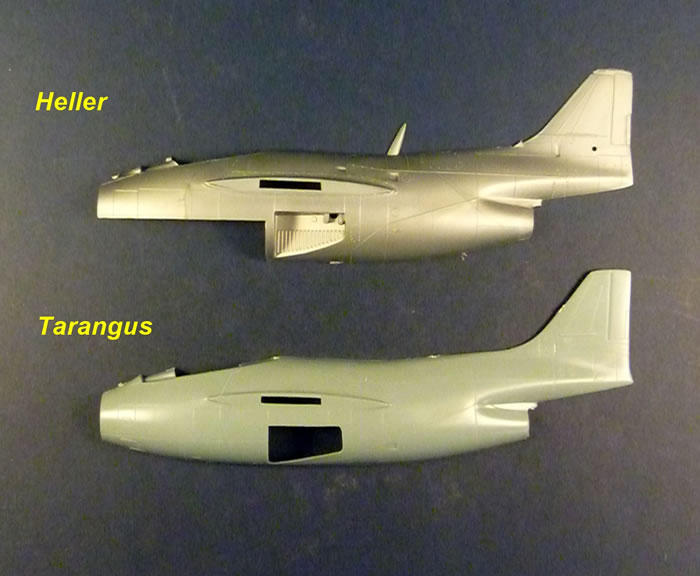
Matching and overlapping parts from the two kits suggests a close to 100% outline agreement, except for the wheel wells and canopy. It seems likely that the Heller kit will have at least influenced, if not provided the basis of the Tarangus master. I have included some images of the two kits' parts side by side. I did notice a difference in the drop tank shape between the two brands; however the Tarangus items, with their widened rear section, correctly reflect those fitted to the F.29B.
The Tarangus differences compared with Heller are described, and in all but one case I feel are more correct than Heller:
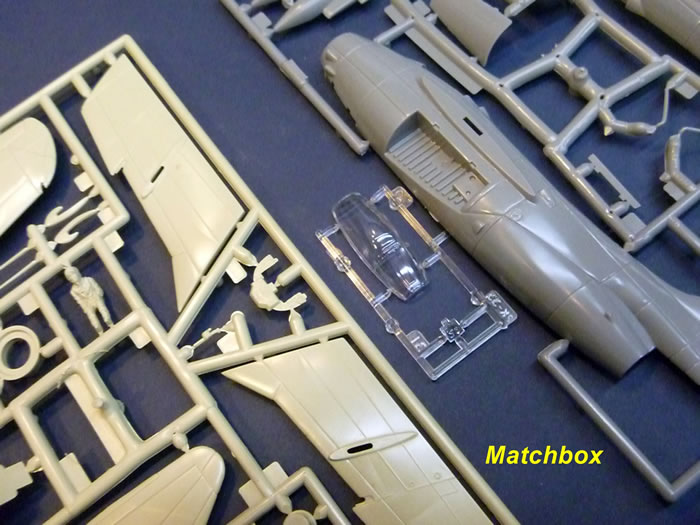
There are several restored J.29 airframes and at least one that flies, so I think is safe to assume that Tarangus have done their homework given their obvious focus on Swedish subjects. I therefore feel that their kit is likely to be very accurate.
More comparison photos are available in the Gallery on this page.
This is the first 1/72 kit by Tarangus, and I hope they do more Tunnan versions as well the likes of a Viggen and Lansen. Quality is very good for a limited run kit, as I would expect given its likely Sword origin. It is good to have a modern and accurate Tunnan kit, especially as of the earlier J.29A/B versions.
This new release from Tarangus is comparatively expensive, costing around 70% more than an equivalent kit by Sword (for example). I am inclined to think that many who just want any version of Tunnan in 1/72 will stick with the much more affordable Heller kit (or indeed convert it to an earlier A or B version). But for those who want an early Tunnan without resorting to surgery, or desire better accuracy and the refined surface detail of a modern limited run kit, then the new Tarangus release is the one to go for. I am happy to recommend it.
Thanks to Tarangus for the review sample.
Review Text and Comparison Images Copyright © 2013 by Mark Davies
Sprue Images Copyright © 2013 by Brett Green
Page Created 14 October, 2013
Last updated
15 October, 2013
Back to HyperScale Main Page
Back to Reviews Page

|
